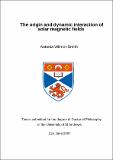Files in this item
The origin and dynamic interaction of solar magnetic fields
Item metadata
| dc.contributor.advisor | Priest, E. R. (Eric Ronald) | |
| dc.contributor.author | Wilmot-Smith, A.L. | |
| dc.coverage.spatial | 140 | en |
| dc.date.accessioned | 2008-01-31T11:30:10Z | |
| dc.date.available | 2008-01-31T11:30:10Z | |
| dc.date.issued | 2008-06 | |
| dc.identifier.uri | https://hdl.handle.net/10023/417 | |
| dc.description.abstract | The dynamics of the solar corona are dominated by the magnetic field which creates its structure. The magnetic field in most of the corona is ‘frozen’ to the plasma very effectively. The exception is in small localised regions of intense current concentrations where the magnetic field can slip through the plasma and a restructuring of the magnetic field can occur. This process is known as magnetic reconnection and is believed to be responsible for a wide variety of phenomena in the corona, from the rapid energy release of solar flares to the heating of the high-temperature corona. The coronal field itself is three-dimensional (3D), but much of our understanding of reconnection has been developed through two-dimensional (2D) models. This thesis describes several models for fully 3D reconnection, with both kinematic and fully dynamic models presented. The reconnective behaviour is shown to be fundamentally different in many respects from the 2D case. In addition a numerical experiment is described which examines the reconnection process in coronal magnetic flux tubes whose photospheric footpoints are spun, one type of motion observed to occur on the Sun. The large-scale coronal field itself is thought to be generated by a magnetohydrodynamic dynamo operating in the solar interior. Although the dynamo effect itself is not usually associated with reconnection, since the essential element of the problem is to account for the presence of large-scale fields, reconnection is essential for the restructuring of the amplified small-scale flux. Here we examine some simple models of the solar-dynamo process, taking advantage of their simplicity to make a full exploration of their behaviour in a variety of parameter regimes. A wide variety of dynamic behaviour is found in each of the models, including aperiodic modulation of cyclic solutions and intermittency that strongly resembles the historic record of solar magnetic activity. | en |
| dc.format.extent | 13330808 bytes | |
| dc.format.mimetype | application/pdf | |
| dc.language.iso | en | en |
| dc.publisher | University of St Andrews | |
| dc.rights | Creative Commons Attribution-NonCommercial-NoDerivs 3.0 Unported | |
| dc.rights.uri | http://creativecommons.org/licenses/by-nc-nd/3.0/ | |
| dc.subject | MHD | en |
| dc.subject | Magnetic reconnection | en |
| dc.subject.lcc | QB539.M23W5 | |
| dc.subject.lcsh | Solar magnetic fields | en |
| dc.subject.lcsh | Sun--Corona--Magnetic fields--Mathematical models | en |
| dc.subject.lcsh | Magnetic reconnection | en |
| dc.subject.lcsh | Dynamo theory (Cosmic physics) | en |
| dc.title | The origin and dynamic interaction of solar magnetic fields | en |
| dc.type | Thesis | en |
| dc.accrualMethod | Magnetohydrodynamics | en |
| dc.contributor.sponsor | Science and Technology Facilities Council (STFC) | en |
| dc.type.qualificationlevel | Doctoral | en |
| dc.type.qualificationname | PhD Doctor of Philosophy | en |
| dc.publisher.institution | The University of St Andrews | en |
This item appears in the following Collection(s)
Except where otherwise noted within the work, this item's licence for re-use is described as Creative Commons Attribution-NonCommercial-NoDerivs 3.0 Unported
Items in the St Andrews Research Repository are protected by copyright, with all rights reserved, unless otherwise indicated.


